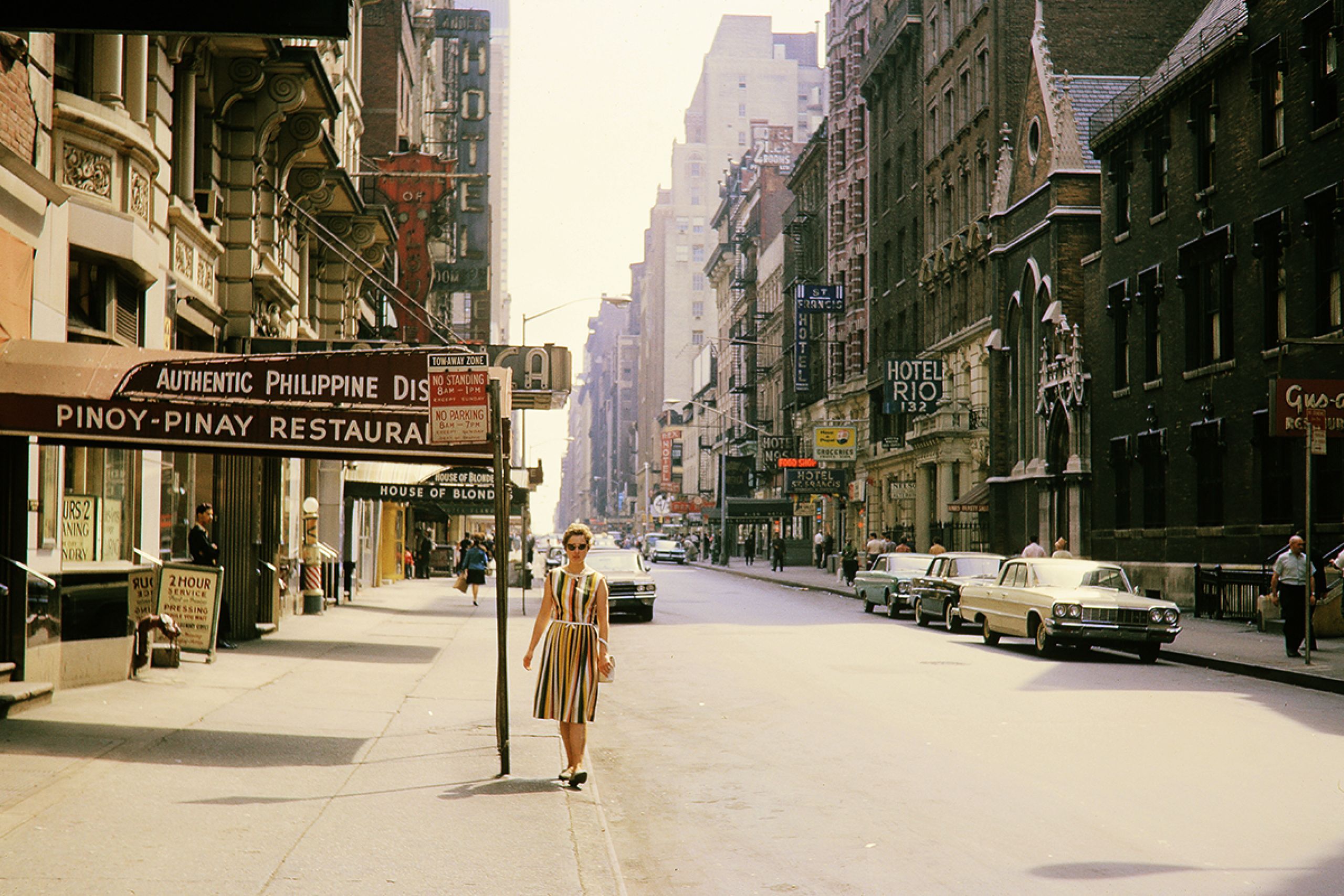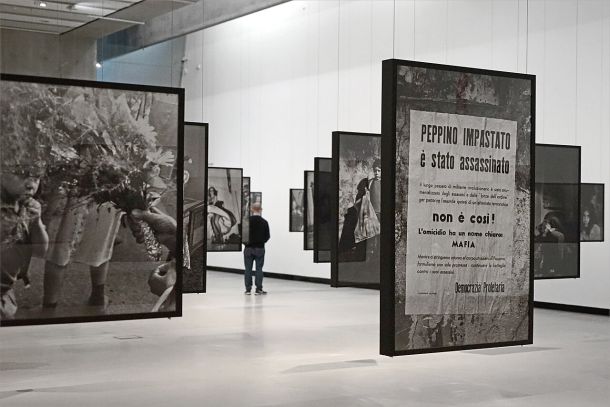American Vernacular Photography: Revealing the Soul of the United States

Stroll – Photo : © André Robé Collection
Authentic America: when the ordinary reveals the extraordinary
Are you looking to understand how American vernacular photography has revealed the true soul of the United States, a practice that transforms ordinary images into extraordinary testaments of a civilization? Our exploration unveils how this photographic approach, born from the democratization of the camera, captured the very essence of America: from New York’s Empire State Building to roadside diners, from suburban neighborhoods to national monuments. Discover how this type of photography, long overlooked by institutions, today reveals the cultural and social complexity of the United States in all its diversity.
Summary
- Vernacular Photography: Revealing Authentic America
- American Iconography through the Popular Lens
- Masters of American Vernacular Photography
- New York and the Empire State: Symbols of Popular Imagery
- The Cultural Impact of Vernacular Photography in the United States
Vernacular Photography: Revealing Authentic America
Origins and Fundamental Characteristics
Vernacular photography refers to these unpretentious images, often taken by amateurs, that capture everyday American life in all its diversity. This genre emerged in the United States at the dawn of the 20th century, fueled by Kodak’s democratic revolution that put the camera into everyone’s hands.
Kodak’s democratization in 1888 allowed ordinary Americans to document their existence: families in their backyards, vacations in Atlantic City, local celebrations, and their state’s landscapes. This technological revolution created an unprecedented visual archive of American society, revealing a multifaceted, authentic America—far from Hollywood clichés.
Characteristics of American Vernacular Photography:
- Everyday spontaneity: unplanned captures of ordinary life
- Geographic diversity: from Manhattan to the Kansas plains
- Social democratization: all social classes represented
- Cultural authenticity: local realities without artistic filtering
- Collective memory: an unintended archive of American evolution
America Revealed through the Popular Eye
This type of photography reveals a complex and nuanced America, far from official or tourist representations. It captures social transformations, internal migrations, and evolving lifestyles—creating an authentic collective portrait of American civilization.
Recurring Themes in American Vernacular Photography:
| Main Theme | Visual Representations | Cultural Insight |
|---|---|---|
| The American Dream | Suburban homes, new cars, family vacations | Aspiration for prosperity and social mobility |
| Geographic Mobility | Road trips, relocations, exploring states | Freedom of movement as a core value |
| Cultural Diversity | Ethnic festivals, community neighborhoods, local traditions | Real melting pot versus proclaimed ideal |
| Technological Innovation | New devices, TVs, cars | Fascination with progress and modernity |
| Local Identity | Regional landmarks, community events | Rootedness despite standardization |
American Iconography through the Popular Lens
Building the National Imagery
Vernacular photography actively contributed to building modern American iconography. By spontaneously documenting iconic places, monuments, and moments, amateur photographers created a shared visual vocabulary that still defines “American-ness” today.
Icons Photographed by Ordinary Americans:
- National monuments: Statue of Liberty, Mount Rushmore, Golden Gate
- Iconic architecture: Skyscrapers, diners, roadside motels
- Symbolic landscapes: Grand Canyon, California beaches, Midwest plains
- Collective events: 4th of July parades, baseball games, graduations
- Urban symbols: Times Square, Hollywood Boulevard, French Quarter
Regional Specificities in Vernacular Photography
Each American region developed its own vernacular aesthetic, reflecting local character while contributing to the national portrait:
| Region | Photographic Traits | Impact on National Imagery |
|---|---|---|
| Northeast | Urban architecture, historic landmarks, dense city life | Modernity, economic power, heritage |
| South | Antebellum architecture, rural landscapes, family traditions | Nostalgia, tradition, racial complexity |
| West | Grand landscapes, new cities, innovation | Frontier, freedom, renewal |
| Midwest | Agriculture, small towns, family values | Authenticity, stability, America’s heartland |
| California | Beaches, Hollywood, relaxed lifestyle | Hedonism, creativity, future |
Masters of American Vernacular Photography
Stephen Shore: Pioneer of Vernacular Color
Stephen Shore revolutionized vernacular photography by introducing color as a legitimate artistic language. His series “American Surfaces” (1972) and “Uncommon Places” (1973–1981) turned everyday America into a visual epic, revealing the hidden beauty of ordinary life.
Shore’s American Universe:
- Cross-country road trips: from New York to Los Angeles through the heartland
- Motel and diner aesthetic: commercial architecture as unintentional art
- Saturated 1970s color: post-hippie American color palette
- Elevated banality: turning the everyday into contemporary art
- Personal visual journal: each image as a fragment of American experience
His photographs of urban and rural America show a unique conceptual approach, turning restaurant receipts, motel rooms, and suburban landscapes into a visual narrative of modern American life.
Walker Evans: Forerunner of the Documentary Gaze
Walker Evans laid the aesthetic foundations of American vernacular photography. His work for the Farm Security Administration during the Great Depression revealed an America in crisis—but also one that was resilient and dignified.
Evans’ Major Contributions:
- “American Photographs” (1938): first conceptual photo book about America
- Rural poverty documentation: human dignity amid economic hardship
- Vernacular architecture: houses, shops, signage as cultural markers
- New York subway portraits: anonymous humanity in urban life
- Frontal aesthetics: direct, unembellished approach—highly influential
Berenice Abbott: Chronicler of Urban Transformation
Berenice Abbott systematically documented the evolution of urban America, especially New York. Her “Changing New York” project (1935–1940) is an exceptional testament to the transformation of the modern American metropolis.
Abbott’s Urban Vision:
- Architectural metamorphosis: construction and destruction as a cycle
- Social contrasts: slums and skyscrapers in the same frame
- Urban energy: motion and speed as the essence of modernity
- Technical precision: sharpness revealing every urban detail
- Social engagement: photography as a sociological tool
William Eggleston: Poet of the American South
William Eggleston revealed the melancholic beauty of the American South through a refined vernacular aesthetic. His saturated colors and unexpected framing turn Memphis and its surroundings into artistic territory.
Eggleston’s Southern America:
- Acidic 1970s colors: post-industrial American color palette
- Everyday objects elevated: tricycles, neon lights, domestic interiors
- Urban nostalgia: fading beauty of middle American towns
- Domestic intimacy: private, familial American spaces revealed
New York and the Empire State: Symbols of Popular Imagery
The Empire State Building in Vernacular Photography
The Empire State Building perfectly embodies the power of vernacular photography to transform a monument into a universal symbol. Since its inauguration in 1931, this skyscraper has been photographed by millions of ordinary Americans, creating a rich popular iconography.
Evolution of Vernacular Representation:
- 1930s: symbol of American ambition during the Depression
- 1940s–50s: backdrop of the rediscovered American Dream
- 1960s–70s: nostalgia for America’s architectural golden age
- 1980s–90s: tourist icon in the global family album
- 2000s–today: heritage monument in digital America
New York as Vernacular Laboratory
New York concentrates all the characteristics of American vernacular photography: social diversity, urban transformation, collective energy. The city is a laboratory for experimentation for both amateur and professional photographers.
Specifics of New York Vernacular Photography:
- Urban density: countless subjects in every frame
- Human diversity: all American communities represented
- Architectural verticality: skyscrapers as visual signatures
- Constant energy: perpetual movement and change
- Global iconography: instant international recognition
Touristic and Family Heritage
Tourist snapshots of the Empire State Building offer a fascinating archive of evolving American family photography. From 120 format film cameras to smartphones, these images tell the technological and social story of modern America.
American Photographic Rituals:
- Group photo at the top: family communion with the icon
- Selfie at the entrance: personal appropriation of the monument
- View from the observatory: symbolic domination of the metropolis
- Dramatic low-angle shot: American grandeur and ambition
- Landscape integration: monument within daily urban life
The Cultural Impact of Vernacular Photography in the United States
Building American Collective Memory
Vernacular photography has played a key role in building American collective memory. By spontaneously documenting social changes, it created an archive parallel to official history—revealing America as it is lived daily.
Contribution to National Identity:
- Democratic archive: all Americans become historians of their time
- Plurality of narratives: multiple viewpoints on American experience
- Cultural continuity: visual transmission of values and traditions
- Social evolution: documentation of lifestyle changes
- Unity in diversity: shared visual vocabulary despite differences
Contemporary Institutional Recognition
Institutions such as MoMA, the Henri Cartier-Bresson Foundation, and the Whitney Museum have gradually incorporated vernacular photography into their collections—recognizing its artistic and historical value.
Institutional Valuation Criteria:
- Documentary authenticity: unfiltered testimony of the times
- Aesthetic innovation: renewal of photographic language
- Social representativeness: diversity of American viewpoints
- Cultural impact: influence on contemporary art and society
- Heritage value: preservation of national memory
Influence on Contemporary Photographic Art
Vernacular photography continues to influence contemporary American art. Many photographers draw from this aesthetic to question modern American identity—creating a constant dialogue between tradition and innovation.
Legacy in Contemporary Art:
- Critical reappropriation: challenging American myths
- Digital hybridization: analog/digital blends inspired by vernacular styles
- Social engagement: photography as a societal insight tool
- Cultural globalization: American vernacular as a global model
- Postmodern nostalgia: return to lost authentic values
The Investment Value of American Vernacular Photography
Artistic and Heritage Value
American vernacular photography is gaining recognition in the art market. Collectors especially value works that combine aesthetic quality, historical authenticity, and cultural representativeness.
Market Value Criteria:
- Historical rarity: unique testimonies of bygone eras
- Technical quality: excellence despite amateurism
- Cultural representativeness: capturing the spirit of an era
- Documented provenance: guaranteed authenticity and traceability
- Aesthetic impact: beauty that transcends documentary intent
Fine Art Prints and Conservation
Vernacular photography fine art prints meet museum standards to ensure their longevity. Limited editions, high-quality papers, and professional framing preserve these visual testimonies of America for future generations.
America Revealed Through Its Ordinary Gaze
American vernacular photography is the most authentic portrait of U.S. civilization. By spontaneously capturing the everyday, it reveals a complex and nuanced America—far beyond tourist clichés and official representations.
From New York’s Empire State Building to Interstate diners, from suburban homes to national parks, this photography draws the emotional map of a constantly changing country. It bears witness to the dreams, struggles, and ordinary hopes that form the true essence of the American experience.
For collectors and lovers of authenticity, investing in American vernacular photography means acquiring a fragment of that collective story—a testament to America as it is lived and imagined each day.
Discover our collection of American vernacular photographs at Une-image-pour-rever.fr, where every print reveals the hidden poetry of authentic America, turning your space into a gallery of shared visual memories.



